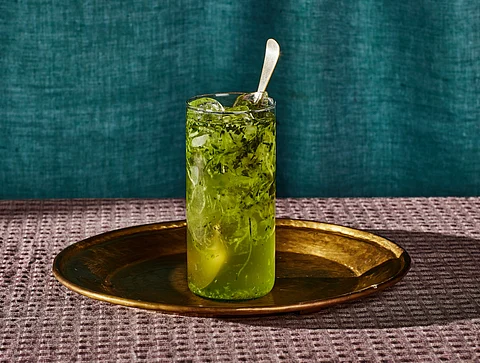
- Destinations
- Experiences
- Stay
- What's new
- Celebrating People
- Responsible Tourism
- CampaignsCampaigns
- Subscribe
- Buy Now

Even as the sun begins to roast all and sundry in the peak summer months in the Iranian plateau, many still turn towards the cooling solace of the very beverage that has soothed Persians for over a thousand years, namely, Sekanjabin. A unique taste profile, this syrup is a sweet-and-sour affair made with vinegar, sugar and infused mint. One of Iran's oldest drinks, Sekanjabin is served over crushed ice or alternatively with crisp, refreshing cucumber slices. This ancient sharbat (drink) deeply exhibits Iran's culinary traditions and the country it has comported to its weather conditions. Today, as global palates hanker for authenticity and regional taste, lost flavours are making a comeback, and within such a climate Sekanjabin quietly reclaims its lost spot as a timeless Persian classic.
The name Sekanjabin finds its origins in the Arabicised form of two Persian words: “serkeh” meaning vinegar and “angabin” meaning honey. The oldest recipes date back to pre-Islamic Iran where the drink enjoyed widespread popularity, especially during the medieval Islamic Golden Age. Over time, while honey came to be replaced by sugar, the core components—vinegar and mint—have remained unchanged.
Traditionally, Sekanjabin was prepared in Persian homes during the hot months and often offered to guests on arrival as a gesture of hospitality. Its tangy, sweet, and herbal complexity made it not just a thirst-quencher but also an embodiment of Persian culinary finesse.
Sekanjabin wasn’t merely a summertime refreshment—it was regarded as medicine in ancient Persia. The traditional Unani and Persian medical texts classify it as a "cooling tonic" which balances the body's inner heat during summer. It was often prescribed for fevers, indigestion and even to temper excess bile, in line with the humoral theories dominant in Islamic and Persian medicine.
The renowned 10th-century Persian physician Avicenna (Ibn Sina) mentioned Sekanjabin in his medical encyclopaedia ‘Canon of Medicine’, noting its use to stimulate appetite and relieve inflammation. The drink’s sourness was considered cleansing, while mint provided digestive relief. For centuries, it served both the noble courts and common households—not only as refreshment but as a remedy.
The cultural significance of Sekanjabin extends far beyond medicine. The drink makes appearances in Persian poetry and literature, often as a symbol of refinement and generosity. In classical Persian verse, sharbats like Sekanjabin were used metaphorically to express emotions, particularly longing and joy.
In some poems of the Qajar and Safavid eras, the act of offering Sekanjabin was an emblem of hospitality and affection. Persian court records show Sekanjabin served alongside elaborate meals, and references appear in texts detailing royal banquets. Even Persian travellers and historians such as Nasir Khusraw documented its use across various regions, often noting how it cooled the body during long caravan journeys.
Traditionally, it is believed that Sekanjabin was made in spring, bottled and stored to be used all summer long. The drink’s preparation was a domestic ritual—boiling sugar or honey with vinegar and fresh mint, then slowly reducing the syrup until fragrant. While the base remained the same, regional versions added cucumber juice, grated cucumber, rosewater, or even lettuce leaves to the drink.
In rural Iran, Sekanjabin is still served by vendors at summer festivals and markets, often in earthen pots with shaved ice or in copper jugs with slivers of cucumber. It is drunk cold, sometimes diluted with water, and sometimes sipped slowly while nibbling fresh fruits.
In recent years, Sekanjabin has experienced a revival among culinary historians and home cooks seeking to restore Iran’s traditional foodways. As part of a broader interest in ancient Persian cuisine, chefs are bringing Sekanjabin back to menus—not only in Iran but also in diasporic communities abroad.
The drink’s natural ingredients and health benefits—mint’s cooling properties, vinegar’s probiotic qualities, and the absence of artificial additives—align with modern wellness trends. Its versatility also makes it a favourite among mixologists, who experiment with it in cocktails or as a syrup base for sodas and mocktails.
All in all, Sekanjabin is more than a drink—it is a cultural artefact and a core piece of Iran’s living heritage. In a world dominated by carbonated drinks and artificial flavours, its simple recipe feels revolutionary. It embodies sustainability, minimalism, and wellness, all while evoking the elegance of Persian civilisation.
Whether you sip it with ice on a hot afternoon, pour it over sliced cucumbers, or experiment with it in a cocktail, Sekanjabin offers a journey into ancient Persia—cool, complex, and beautifully timeless.
